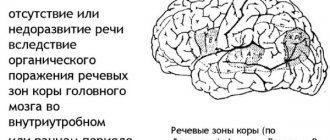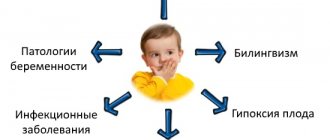One of the necessary conditions for a child’s successful education at school is the quality of his reading.
Reading is, first of all, a process of understanding what is read. But understanding largely depends on reading speed. The optimal reading speed is considered to correspond to the tempo of spoken speech, i.e. approximately 130-150 words per minute.
Why do some children achieve these parameters quickly enough, while others fail to achieve this result even by the end of 4th grade? The reasons may be different. In this article I will focus on one of them. This is an insufficient point of view.
How to expand the scope of vision?
Exercises using Schulte tables can help with this. The tables are numbers placed in a chaotic order; in the center of the table there is a sign for focusing vision. Trying to look only at it, you need to see all the numbers and go through them sequentially. There are tables without marking the center, but then you need to remember this and try to focus your gaze on the center of the table.
Regular work with Schulte tables will allow you to:
- develop attention and memory;
- activate the development of thought processes;
- expand the angle of view;
- activate brain development;
- develop reaction speed.
In addition, Schulte tables have long been used to improve reading skills.
By training with Schulte tables, children develop excellent attention and memory. When performing the exercise, the brain must perform two tasks simultaneously: keep all the numbers in sight and name them in a certain order.
In the future, when reading, the child will see a larger fragment of the text and will begin to correctly read the endings of words due to the fact that he will see the entire word until the moment of reading. This will help not only increase reading speed, but also improve the quality of reading.
How to work with Schulte tables?
- Place the table at a distance of 30-40 cm from the child’s eyes;
- The child finds the center of the table and fixes his gaze;
- Without making eye movements, the child finds and shows all the numbers in order;
- Change the table periodically.
And now in more detail: what are Schulte tables for?
1. Exercises with such tables are useful when training speed reading. Thanks to regular work with them, peripheral vision improves, the speed of information perception increases, as well as the amount of text that we can capture with our eyes at once, and therefore, reading speed increases.
2. Working with Schulte tables develops speed of thinking and visual memory. In addition, if you have learned to read faster, then you have the opportunity to study more of the literature you need and “pump up” your intelligence.
3. The Schulte table was originally developed by the German psychiatrist and psychotherapist Walter Schulte in the 1960s and 70s as a psychodiagnostic test for studying attention. And to this day, such tables are often used in psychology to determine the presence or absence of attention disorders and assess the level of performance. In this case, experts analyze the number of missing digits and the time spent.
4. Schulte tables are periodically used in neurolinguistic programming trainings in order to achieve a highly productive state when consciousness switches from critical thinking to performing logical and sequential operations.
Courses for developing speed reading and brain training
Would you like to quickly read books, articles, newsletters, etc. that interest you? If your answer is “yes,” then our course will help you develop speed reading and synchronize both hemispheres of the brain.
With synchronized, joint work of both hemispheres, the brain begins to work many times faster, which opens up much more possibilities. Attention , concentration , speed of perception are enhanced many times over! Using the speed reading techniques from our course you will be able to:
- Learn to read quickly
- Improve attention and concentration, as they are important when reading quickly
- It's easy to read one book a day
- Work faster and more carefully
Sign up for a courseFree lesson
Secrets of brain fitness, training memory, attention, thinking, counting
If you want to speed up your brain, improve its functioning, improve your memory, attention, concentration, develop more creativity, perform exciting exercises, train in a playful way and solve interesting problems, then sign up. 30 days of powerful brain fitness are guaranteed.
Sign up for a courseRead more
Super memory in 30 days
As soon as you sign up for this course, you will begin a powerful 30-day training in the development of super-memory and brain pumping.
Within 30 days after subscribing, you will receive interesting exercises and educational games in your email that you can apply in your life.
We will learn to remember everything that may be needed in work or personal life: learn to remember texts, sequences of words, numbers, images, events that happened during the day, week, month, and even road maps.
Sign up for a courseRead more
How to improve memory and develop attention
Free practical lesson from advance.
Sign up for freeRead more
We speed up mental arithmetic, NOT mental arithmetic
Secret and popular techniques and life hacks, suitable even for a child. From the course you will not only learn dozens of techniques for simplified and quick subtraction, addition, multiplication, division, and calculating percentages, but you will also practice them in special tasks and educational games! Mental arithmetic also requires a lot of attention and concentration, which are actively trained when solving interesting problems.
Sign up for a courseRead more
Money and the Millionaire Mindset
Why are there problems with money? In this course we will answer this question in detail, look deep into the problem, and consider our relationship with money from psychological, economic and emotional points of view. From the course you will learn what you need to do to solve all your financial problems, start saving money and invest it in the future.
Sign up for a courseRead more
How to work with Schulte tables?
If the goal is to learn speed reading, then it is important to count not just quickly, but also silently, since articulation slows down reading.
When training on the Schulte table, experts advise focusing your gaze on its center in order to see it completely. The desired effect from the table is achieved when there is less eye movement. The farther you place the table from yourself, the more convenient it is. The most appropriate distance will be the one you usually keep from a book or monitor while reading. As a rule, this is from 40 to 50 cm. Some recommend a distance of 30–35 cm. You should not move too far from the table either.
When working with Schulte tables, experts advise focusing not on finishing the numbers quickly, but on the main goal - training visual skills while following the methodology. To begin with, learn not to “jump” your gaze from one cell to another and not to pronounce numbers or letters out loud. The more you practice, the faster you will be able to find all the numbers in sequence.
It would seem that everything is elementary, but suppressing articulation without practice can be quite difficult. Experts recommend doing several exercises. To begin with, while reading the text, try to pronounce to yourself not this text, but some combinations of sounds, then move on to words, tongue twisters, and counting. It is important that at the same time you are able to perceive the meaning of what you read.
As soon as it starts to work out, move on to a new exercise: put your finger to your lips while reading and try to control your lips and tongue - they should not move. Slide your gaze over the text, gradually accelerating. Instead of holding your finger to your lips, you can hold a pencil between your teeth.
Turn on the music and tap its rhythm while reading the text.
Finally, try moving your finger along the line and reading while keeping up with it. This way you simply won’t have time to pronounce the text.
Purpose
This technique is intended to identify in school-age children the qualities necessary for successful development of the school curriculum, such as:
- attentiveness;
- stability of attention;
- ability to concentrate;
- ability to work effectively independently;
- mental stability;
- ability to analyze information;
- the pace of indicative search movements of the gaze and the amount of attention.
This technique is aimed at improving - sharpening and expanding peripheral vision - a very important parameter that is crucial for the pace of reading, since it is this that allows you to reduce the time period spent searching for the necessary parts of the text.
Thus, Schulte tables have not only diagnostic value, but can also be used as a speed reading simulator.
Parameters affected by training using Schulte tables:
- speed and strength of assimilation of new information;
- training in critical evaluation of acquired knowledge;
- efficiency of memorizing new information;
- the ability to concentrate attention on a specific action.
The Schulte method has one more important positive quality: it takes very little time for a student to take the test and interpret the results.
Types of Schulte tables
There are tables of different types and levels of difficulty.
The easiest ones are tables for children and beginners - from 3x3 in size, with large numbers. The training will be useful for children who are learning to count and also developing reading speed (the optimal speed is considered to be 130 words per minute).
Expanding the scope of vision, which is facilitated by exercises with Schulte tables, will help the child master speed reading skills. And the development of memory, concentration and speed of reaction will not be superfluous, because a junior student at school needs to listen to the teacher and write, solve problems and remember the rules. And also - to absorb a lot of material on different subjects.
Invite your child to read the numbers forward and backward. Initially, you can help him by pointing to the required numbers with a pointer, highlighting them with a pencil. Gradually increase the number of cells.
Ask to carefully study the table for 10 seconds, then turn it over and look at it again, and then, turning the front side towards you, quickly draw a continuous line connecting all the numbers in the table in order. Let the child say the numbers out loud.
If it is important for you to evaluate the effectiveness of this exercise, keep in mind: for a six-year-old child, about a minute on a table with numbers up to 16 is a brilliant result (a “five”), 61–70 seconds is optimal (“four”), 71– 80 - a C grade. At seven years old, the task becomes more complicated: to complete an “excellent” task, you need to spend 51–55 seconds, and to achieve a “B”, 56–65 seconds. For an eight-year-old schoolchild, the task for “5” is to complete it in 46–50 seconds, for “4” – 51–60. At nine years old, a student is able to spend ideally 41–46 seconds, for a “B” – 46–55. Well, at ten years old the result is “excellent” – already 36–40 seconds, and “good” – 41–50.
The tables should be changed periodically: over time, the child can simply remember where this or that number is located.
It's time to move to the second level when the tables of the first are easy. Usually, Schulte tables of the second level are understood as traditional ones, with 25 cells (5x5 cells).
By the way, British psychologist Tony Buzan noted that it is a little easier to train on hand-drawn tables: on a computer screen, the eye is involuntarily “distracted” by the cursor.
The third, complicated level is large tables (up to 10x10) and Gorbov-Schulte tables (red-black).
Gorbov-Schulte tables
The Gorbov-Schulte table is a 7 by 7 square, where numbers up to 25 are randomly scattered in black cells and up to 24 in red cells. Sometimes the colors of the numbers themselves, rather than the cells, may differ. The task here becomes more complicated: find the black numbers in ascending order, and the red numbers in descending order, and alternately: 1st black and 24th red, 2nd black and 23rd red, and so on.
Working with this type of table helps to assess the speed of switching attention. If you wish, you can record the results of your work here: say the numbers out loud and ask someone to record the time and errors (changing the order of numbers or colors). A 7x7 table should take about a minute and a half. The more mistakes, the worse things are with switching attention.
By training, you develop both speed reading and the ability to quickly perceive graphic information along with text. This skill will be useful when studying websites and magazines.
Schulte letter tables
Another modification of classic tables is letter tables. The meaning of the work is the same as with a regular table, only instead of numbers there are letters. According to experts, such tables develop speed reading skills even better. In this case, it is important to remember the sequence of letters in the alphabet. There are even Schulte alphabet tables in Latin on the Internet.
I also advise you to pay attention to other exercises
The complex will be harmoniously complemented by:
- Tongue Twisters
- consonant tables
- role and choral reading
- “tug” (the adult runs his finger along the lines, the child speaks out loud)
- answers to questions after the work
- learning poetry by heart.
Studying is a difficult period in the life of parents. I don’t even know who has it more difficult. I can only say one thing for sure: you need to teach your child to study, and not to do tasks for him! This is the first step towards independence. How do you prepare for school?
I wish you big and small victories!
At what age can you practice speed reading?
Speed reading lessons will only be useful if the child, in principle, can read well. Therefore, experts do not advise starting immediately from the first grade, when it is important to master a leisurely and thoughtful understanding of the text. At this time, it is better not to pay attention to speed at all, allowing the child to move at his own pace.
Most exercises for developing speed reading are intended for children 9-10 years old. Some teachers even believe that they can interest a child only in adolescence, when he understands the meaning of such activities.
But this does not mean that any techniques should be postponed until the age of 9. With preschoolers and first-graders, you can develop attention, do exercises to expand the field of vision, and visualize what you read. The ability to concentrate and imaginative thinking will help the child quickly learn new things when it comes time for special speed reading exercises.
Key Skills for High Reading Speed
Some skills can and should be trained at any age - they will be useful for both children and adults:
- ability to focus attention and not be distracted;
- wide field of view, developed peripheral vision;
- the ability to structure information and highlight the main thing;
- large amount of RAM;
- high speed of thinking.
Classes to develop these qualities can be carried out both in parallel with learning speed reading, and separately. At a younger age, they will prepare the child for school, and will help schoolchildren and adults process text material faster and better assimilate what they read.
In addition, almost all of these skills are closely related to each other and by developing one of them, you can improve others. For example, when we learn to structure information, at the same time we remember it - this is how memory becomes better and the speed of thinking increases.
What is considered fast reading: standards and records
For a first-grader, by the end of the school year, a reading speed of 25 to 40 words per minute is considered normal.
By the end of 4th grade, a child should read from 90 to 120 words per minute or more.
In middle and high schools, reading technique is not tested, but it is believed that the average teenager and adult reads about 180 words per minute.
A high indicator can be called a result of 400 sl/min. Speed reading training helps improve average results by 2-3 times or more.









